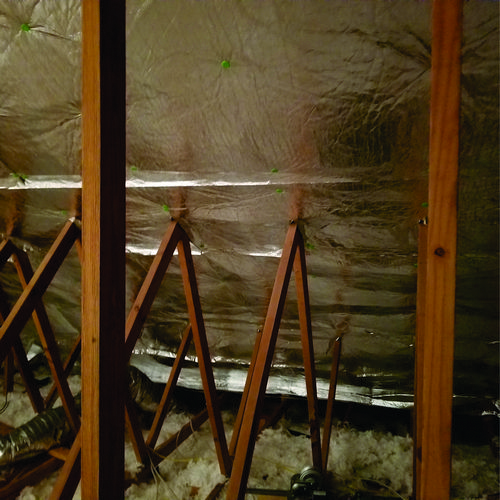Radiant Barrier, Alien Technology?
By Chris Balzer

I have been in the home improvement industry for over 16 years and have heard just about all the sales gimmicks and cheeky techniques used by sales people. One slightly stretched story I have heard about radiant barrier is: did you know that radiant barrier was developed by NASA from alien technology? If only radiant barrier was so glamorous. Actually, in 1925 two German businessmen filed for patents on reflective surfaces for use as building insulation. This became the launching pad for reflective insulation. NASA did help to improve this technology that reflects 97% of radiant heat and adopted it for the Apollo program. This metalized film was used to protect spacecraft, equipment and astronauts from thermal radiation. Radiant barriers have been used in the student housing at the Massachusetts Institute of Technology (MIT), Princeton, and Frank Sinatra’s residence in Palm Springs, California. Radiant barrier was even inducted into the Space Technology Hall of Fame in 1996.
What is radiant barrier? When radiant solar energy strikes a roof, heating the roofing material (shingles, tiles or roofing sheets) and roof sheathing, it causes the underside of the roof surface and the roof framing to radiate heat downward through the roof space (attic / ceiling cavity) toward the attic floor (upper ceiling surface). When a radiant barrier is installed on the rafters in the attic, much of the heat radiated from the hot roof is reflected back toward the roof and the low emissivity of the underside of the radiant barrier means that very little radiant heat is emitted downwards.

Why is that important? Many of our attics will reach into the 150° to 160° degree F range during summer; heating up insulation, ductwork and many times our stored belongings. Anyone who has stored candles in the attic knows what I mean. This extreme heat makes our current insulation and air conditioners work harder to keep our homes cool, costing us money and comfort. Properly installed radiant barrier on the roof rafters will reflect 97% of the radiant heat reducing the attic temperature during this extreme heat by 40° to 50° degrees F, allowing your insulation and ductwork to perform better saving you money and increasing your comfort.
One common misconception regarding radiant barrier is that the heat reflecting off the radiant barrier back to the roof has the potential to increase the roof temperature and possibly damage the roofing material voiding my warranty. Performance testing by Florida Solar Energy Center showed that the increase in temperature at the hottest part of the day was no more than 2° to 5° degrees F. RIMA International wrote a technical paper on the subject which included statements collected from large roofing manufacturers, and none said that radiant barrier would in any way affect the warranty.
To improve on this technology, we perforated our radiant barrier allowing your attic to breath (this is critical in a vented attic system) and sandwiched a piece of high density insulation between two pieces of radiant barrier allowing our radiant barrier to help fight against not only radiant heat, but conduction and convection heat as well. If you would like to learn more or see a demonstration on how radiant barriers works, contact us at 850-588-2870 or visit us at www.trusteces.com.
Chris Balzer is Founder and President of Emerald Coast Energy Solutions and resides in the Santa Rosa Beach area with his wife and 3 Children. For more information on how to save this summer and become energy efficient schedule an inspection by calling (850) 588-2870, visit www.trusteces.com or email wecare@trusteces.com and Beat the Heat.
The post Energy Tips from Emerald Coast Energy Solutions appeared first on South Walton Life | 30A News, Events and Community Information.

Be the first to comment on "Energy Tips from Emerald Coast Energy Solutions"